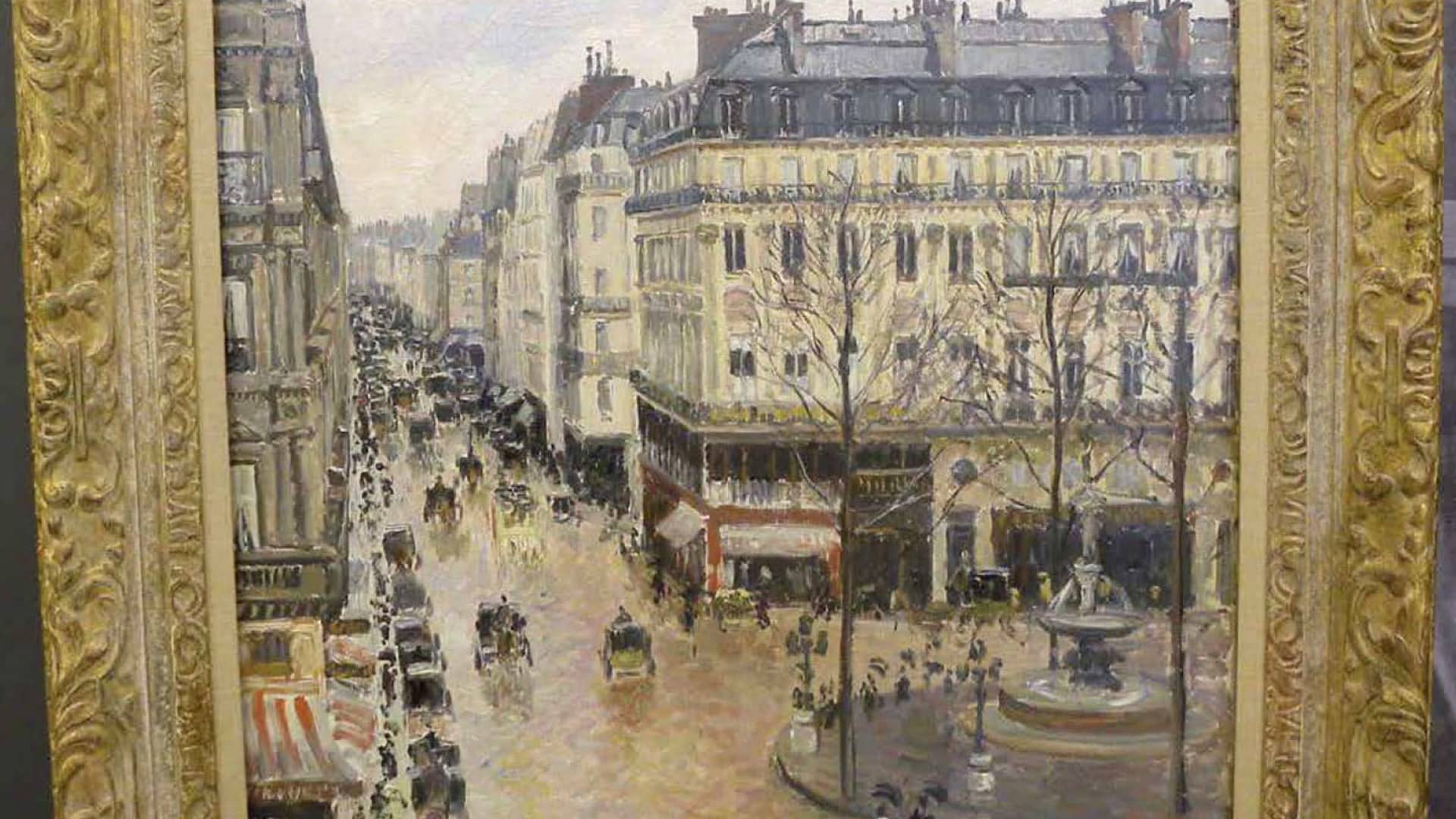Supreme Court revives lawsuit involving a multi-million-dollar French painting, Nazis and Spanish museum
The U.S. Supreme Court resurrected a lawsuit over the ownership of a French painting that a Jewish woman surrendered to the Nazis.

Camille Pissarro's "Rue Saint-Honore in the Afternoon. Effect of Rain, 1897" is seen at Thyssen-Bornemisza museum in Madrid, Spain, April 22, 2022.
Susana Vera | Reuters
The U.S. Supreme Court in a unanimous ruling Thursday resurrected a lawsuit over the ownership of a French painting — now in the possession of a renowned museum in Spain — that a Jewish woman surrendered to the Nazis in 1939 so that she could flee Germany.
The Supreme Court's ruling gave new hope to the Cassirer family that it will recover the Camille Pissarro painting, titled "Rue Saint-Honoré in the Afternoon, Effect of Rain," which is in the possession of the Thyssen-Bornemisza Collection Foundation in Madrid.
The foundation for more than two decades has refused to return the painting, believed to be worth tens of millions of dollars to the descendants of Lilly Cassier, who was forced to turn it over to the Nazis in exchange for her freedom.
In the Supreme Court opinion, Justice Elena Kagan wrote that lower courts had erred in choosing a federal method to determine which law — California property law or Spanish law — would be used to rule on whether the foundation legally owned the painting.
Section of Pissarro's Rue Saint-Honoré in the Afternoon, Effect of Rain
Source: The Supreme Court
An earlier trial in a federal district court in California, which ordered that Spanish law be used in the case filed under the Foreign Sovereign Immunities Act, resulted in a ruling that the foundation was the legal owner.
The dispute over the painting's ownership now will return to that district court, which the Supreme Court said Thursday must use California's state rule, and not the federal method, for determining which law should be applied in such a dispute.
"The path of our decision has been as short as the hunt for Rue Saint-Honoré was long; our ruling is as simple as the conflict over its rightful owner has been vexed," Kagan wrote.
"A foreign state or instrumentality in an FSIA [Foreign Sovereign Immunities Act] suit is liable just as a private party would be ...That means the standard choice-of-law rule must apply. In a property-law dispute like this one, that standard rule is the forum State's (here, California's) — not any deriving from federal common law," Kagan wrote.
But she also noted that, "The underlying question in this case — which this opinion will not resolve — is whether the Cassirer family can get the painting back."
One of the Cassirer family's lawyers, Scott Gant of the firm Boies Schiller Flexner, said that when the case returns to the district court with the ruling in hand the family will again ask that California law be used in a second trial.
Gant said there is "a huge difference" between California and Spanish law on the question of whether a buyer of stolen artwork can continue owning the property if they had a good faith basis to believe the art was not stolen., which he said
"Under California law even good faith purchases of stolen property can't prevail" in a lawsuit about ownership, Gant said.
"Applying California's law will make all the difference in the outcome of this case."
Gant said he was hopeful, if not optimistic, that the foundation would return the painting without going to trial again.
The lawyer said people should be asking the Kingdom of Spain, which created the foundation, "Why are you insisting on maintaining ownership when there is no dispute that it was stolen by the Nazis from Lilly Cassirer?"
David Cassirer, the great-grandson of Lilly Cassirer, poses for a photo outside the Supreme Court in Washington, Tuesday, Jan. 18, 2022.
Susan Walsh | AP
The Spanish Embassy in Washington did not immediately respond to a request for comment.
Lilly's grandson Claude Cassirer, who was the original plaintiff in the case, died in 2010.
His son, David Cassirer, succeeded him as a plaintiff in the case, as did the estate of Claude's late daughter, Ava, who died in 2018, and the Jewish Federation of San Diego.
"It's a lucky day, and a happy day and a long time coming," David Cassirer told CNBC in a phone interview Thursday after the ruling.
"It's very important to the family," said Cassirer, a 67-year-old resident of Telluride, Colo.
"The Supreme Court is sending out a message that I think will be heard all over the world: You don't get to keep artwork that was stolen by the Nazis from Holocaust victims."
"My father would have been thrilled" by the ruling," Cassirer said. "He always thought the greatest day of his life ... was when he became a U.S. citizen."
Cassirer blasted the Thyssen-Bornemisza Collection Foundation for "not doing the right thing here," saying the museum had to have known that the Pissaro had been looted by the Nazis.
He noted that a label for his family's former art gallery in Berlin is still stuck on the back of the painting, which is on display at the Thyssen-Bornemisza National Museum.
A lawyer for the foundation did not immediately respond to a request for comment.
Paul Cassirer, whose family owned a leading art gallery in Berlin and publishing house, purchased the Impressionistic artwork at the center of the case from an agent for Pissaro in 1900.
More than two decades later, the painting was inherited by Lilly Cassirer, the daughter-in-law of Bruno Cassirer, Paul's cousin and a co-owner of the Berlin gallery.
The painting hanging in Lilly Cassirer's home in Germany
Source: The Supreme Court
"But in 1933, the Nazis came to power. After years of intensifying persecution of German Jews, Lilly decided in 1939 that she had to do anything necessary to escape the country," Kagan wrote.
"To obtain an exit visa to England ... she surrendered the painting to the Nazis," Kagan wrote.
Lilly and her husband Otto eventually ended up in the United States as did their son Claude, after being liberated from a French internment camp in Morocco in 1941, according to David Cassirer.
After World War II ended, the Cassirer family searched for the painting but was unable to find it, despite the fact that it sat in a private collection in St. Louis, Mo., from 1952 to 1976.
"After being legally declared the rightful owner, Lilly agreed in 1958 to accept compensation from the German Federal Republic — about $250,000 in today's dollars," Kagan wrote in that decision.
In 1976, the painting was bought by Baron Hans Heinrich Thyssen-Bornemisza, the descendant of the founder of a German steel empire. The baron had it hung in his residence in Switzerland until
the early 1990s, Kagan wrote.
The baron later sold the painting, and much of the rest of his art collection, to the Thyssen-Bornemisza Collection Foundation, an entity created by the Kingdom of Spain. The kingdom, which financed the $300 million purchase of the collection, gave the foundation a palace in Madrid, which served as the museum for the collection.
Claude, whose grandmother Lilly had died in 1962, learned in 1999 from an acquaintance that the Rue Saint-Honoré was in a catalog of the museum's holdings.
After other efforts to recover the painting from the foundation failed, Claude in 2005 sued it in federal court in California, where he lived at the time. He claimed he was the rightful owner of Rue Saint-Honoré, and entitled to its return.
The Foreign Sovereign Immunities Act normally gives foreign states or their instrumentalities, such as the foundation, immunity from being sued.
But the lower U.S. courts who first handled Claude's case allowed it to proceed on the grounds that "the Nazi confiscation of Rue Saint-Honoré brought Claude's suit against the Foundation within the FSIA exception for expropriated property," Kagan noted in the ruling.
To determine which property law governed the case, the lower courts had to apply what is known as the choice-of-law rule.
The Cassirer family wanted to use California's choice-of-law rule, but the foundation argued for a rule based on federal common law.
The district court opted for the federal option. It cited precedent from cases in the U.S. Circuit Court of Appeals for the 9th Circuit, the appellate court that covers western states including California.
The 9th Circuit was the only federal appeals court to use the federal choice-of-law rule to pick the law to apply in FSIA cases that are related to non-federal claims such as property, contracts, and torts. All other federal appeals courts "apply the choice-of-law rule of the forum State," Kagan noted.
Following the 9th Circuit's guidance to use the federal method, the district court determined after the trial that Spanish law would apply in the case.
And under Spanish law, lower courts had found, "the Foundation was the rightful owner [of the painting] because it purchased Rue Saint-Honoré without knowing the painting was stolen and had held it long enough to gain title through possession," Kagan noted in her ruling.
Kagan wrote that the decision to use the federal option for determining which law would apply in such a lawsuit was a mistake.
She noted that Section 1606 of FSIA provides that in any lawsuit in which a foreign state is not entitled to immunity under that act, "the foreign state shall be liable in the same manner and to the same extent as a private individual under like circumstances."
"When a foreign state is not immune from suit, it is subject to the same rules of liability (the same
substantive law) as a private party," Kagan wrote.
Thursday's ruling means that all federal courts, when considering similar FSIA lawsuits, must apply the choice-of-law rule for the state in which the suits are filed.

 JaneWalter
JaneWalter 






























